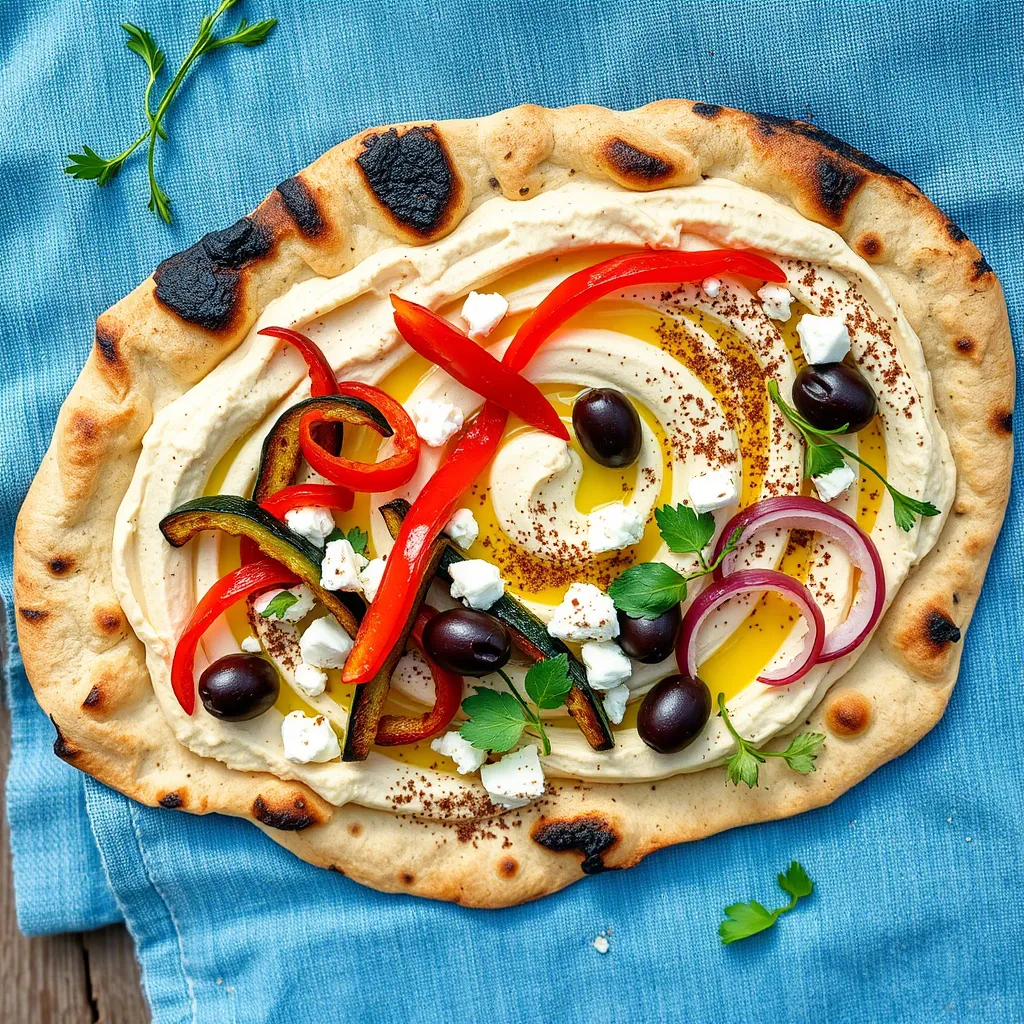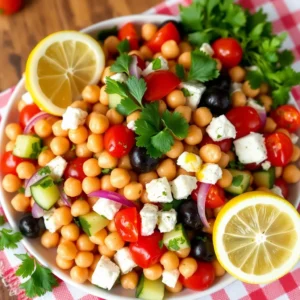Why You’ll Love This Mediterranean Hummus Flatbread
Picture this: it’s Wednesday evening, the kids are hangry, your partner just texted they’ll be home in 20 minutes, and you’re staring into the fridge wondering how on earth you’re going to pull dinner together. We’ve all been there, right? That’s exactly why this hummus flatbread recipe has become my saving grace on busy weeknights. It’s what I like to call a “life raft meal” – the kind that keeps you afloat when you’re drowning in to-do lists and hunger pangs.
What makes this Mediterranean creation so special? For starters, it’s ready in just 30 minutes – and I’m talking start-to-finish, not those recipes that claim “30 minutes” but conveniently forget about the two hours of prep work. This is the real deal, quick enough to make even when your toddler is clinging to your leg and your teenager is dramatically announcing they’re “literally starving to death.”
The beauty of this hummus flatbread lies in its versatility. Got some leftover rotisserie chicken? Throw it on. A lone zucchini rolling around in the vegetable drawer? Perfect! That half jar of olives from last week’s pasta? They’ve found their purpose. This recipe rolls with whatever you’ve got, making it the ultimate clean-out-the-fridge meal that somehow always tastes intentional.
For my busy mom friends who are juggling soccer practice carpools and work presentations, this recipe is a godsend. You can prep components ahead of time, making assembly even quicker when the dinnertime chaos hits. And unlike some “quick” meals that leave you feeling like you’ve just eaten cardboard, this Mediterranean treat delivers big, bold flavors that transport you straight to a seaside taverna – even if you’re actually eating it while refereeing sibling squabbles at your kitchen counter.
The combination of creamy hummus, warm flatbread, and za’atar-roasted vegetables creates layers of texture and flavor that feel downright luxurious. It’s the kind of meal that makes your family think you’ve been slaving away all afternoon, when really you just threw it together during a commercial break of your favorite show. Now that’s what I call kitchen magic!
And let’s talk nutrition for a moment. As a parent, I’m always trying to sneak more veggies into our meals, and this flatbread is basically vegetable delivery in disguise. The colorful array of roasted vegetables not only looks Instagram-worthy but provides a rainbow of nutrients. Plus, the protein from the hummus makes this substantial enough to satisfy even the biggest appetites in your household. It’s what nutritionists call “nutrient-dense” – I just call it a win-win.
For those of you with picky eaters (I see you, and I feel your pain), this recipe has another superpower: customization. You can set up a build-your-own flatbread bar and let everyone top their portion exactly as they like. Suddenly, dinner isn’t a battle but an adventure. It’s amazing how kids who “hate vegetables” will happily pile them on when they’re in charge of their own creation.
The Story Behind This Mediterranean Hummus Flatbread
This hummus flatbread recipe was born on one of those chaotic summer days when the kids had been home all day, the house looked like a tornado had ripped through it, and I couldn’t face another round of mac and cheese. I had some homemade hummus in the fridge (check out my [fool-proof hummus recipe] for a game-changing dip that’ll make you swear off store-bought forever) and half a package of flatbreads that needed using up.
As I foraged through the produce drawer, finding a bell pepper here, some cherry tomatoes there, I remembered a little café my wife and I had discovered on our anniversary trip to Greece years ago. The owner, a grandmotherly woman with hands that moved like poetry, had served us the most incredible flatbreads topped with local spreads and vegetables that had been kissed with herbs I couldn’t identify. When I asked about her secret, she’d laughed and pulled out a little tin of za’atar – a Middle Eastern spice blend that transforms anything it touches.
That night, as Mediterranean-inspired ingredients piled up on my counter, I decided to recreate a bit of that memory. I spread the hummus on flatbreads, scattered roasted vegetables seasoned with za’atar across the top, and finished with a drizzle of olive oil and a squeeze of lemon. It was a shot in the dark, a hail Mary pass at dinnertime.
My youngest, who normally approaches vegetables with the same enthusiasm most people reserve for tax audits, took one bite and declared, “Daddy, this is pizza but better!” My heart nearly burst. My oldest, typically too cool to compliment anything I make, went back for seconds…and thirds. My wife raised her eyebrows in that “where has this been all our lives?” way that makes all the cooking worth it.
Since that night, this Mediterranean hummus flatbread has made weekly appearances at our table. It’s evolved over time, with seasonal vegetables coming and going. Sometimes we add feta, sometimes we keep it vegan. In summer, we grill the flatbreads and vegetables outside, making the process even more carefree.
What I love most about sharing this recipe with you is knowing it might become part of your family’s story too. Maybe it’ll be your Thursday rescue meal, or perhaps your kids’ friends will request it during sleepovers. Food isn’t just sustenance – it’s the backdrop to our lives, the silent witness to our family dynamics, celebrations, and everyday moments.
This Mediterranean flatbread reminds me of something my grandmother used to say: “Simple ingredients need nothing but love to become extraordinary meals.” She was right, of course. This recipe isn’t complicated or fancy, but it carries love in every bite – love for feeding our families well, for bringing a touch of somewhere exotic to our everyday tables, and for creating meals that nourish both body and soul.
So as you prepare to make this hummus flatbread for the first time, know that you’re not just following a recipe – you’re continuing a tradition of care that stretches across kitchens and generations. And if your kids actually eat vegetables without complaint? Well, that’s just the cherry tomato on top.
Ingredients
Let’s talk about what you’ll need to create this Mediterranean masterpiece. The beauty of this hummus flatbread is that while I’ll give you my favorite combination, this recipe is incredibly forgiving and adaptable to whatever you have on hand.
For the base, you’ll need:
- 4 store-bought flatbreads (I prefer oval naan-style, but pita works beautifully too)
- 2 cups hummus (homemade or store-bought – no judgment here, we all have those days!)
- 2 tablespoons extra virgin olive oil, plus extra for drizzling
- 1 tablespoon za’atar spice blend (more on this magical ingredient in a moment)
- 1 lemon, cut into wedges for serving
For the roasted vegetables:
- 1 medium red bell pepper, thinly sliced
- 1 medium yellow bell pepper, thinly sliced
- 1 small red onion, thinly sliced
- 1 medium zucchini, cut into half-moons
- 1 pint cherry tomatoes, halved
- 3 cloves garlic, minced
- 2 tablespoons extra virgin olive oil
- 2 teaspoons za’atar
- 1/2 teaspoon sea salt
- 1/4 teaspoon freshly ground black pepper
For the optional toppings (but highly recommended):
- 1/2 cup crumbled feta cheese (omit for vegan version)
- 1/4 cup kalamata olives, pitted and roughly chopped
- 2 tablespoons pine nuts, lightly toasted
- 1/4 cup fresh herbs (a mix of mint, parsley, and dill works wonders)
- Pinch of red pepper flakes for those who like a bit of heat
Now, let’s talk about these ingredients in more detail, because knowing your ingredients is half the battle in creating something extraordinary.
The flatbread serves as your canvas. While I specify store-bought for convenience, if you’re having one of those “domestic goddess” days, homemade flatbread takes this recipe to another dimension. Check out this reliable flatbread recipe from Serious Eats for inspiration – their no-knead approach means minimal effort for maximum reward.
Hummus is the creamy foundation that brings everything together. Store-bought is perfectly fine (we’re all human), but if you have 15 extra minutes, homemade hummus will elevate this dish significantly. The secret? Ice-cold water while blending and peeling your chickpeas if you’re feeling particularly dedicated. Either way, be generous with this layer – skimping on hummus is a missed opportunity for flavor.
Za’atar is the not-so-secret ingredient that makes this flatbread sing. This Middle Eastern spice blend typically includes dried thyme, oregano, marjoram, sumac, and toasted sesame seeds. It adds an unmistakable earthy, tangy, and slightly nutty flavor that’s impossible to replicate with any other seasoning. You can find it in most well-stocked grocery stores, specialty food shops, or online. In a pinch, you can make your own by mixing 1 tablespoon each of dried thyme and sesame seeds with 1 teaspoon each of dried oregano and sumac, plus a pinch of salt.
For the vegetables, feel free to swap based on what’s in season or what’s lurking in your produce drawer. Eggplant, summer squash, or mushrooms all work beautifully. The key is to slice everything relatively thin so it roasts quickly and evenly. And don’t skimp on that red onion – as it roasts, it transforms from sharp and pungent to sweet and caramelized, adding an essential layer of flavor.
The optional toppings are where you can really make this recipe your own. Feta adds a salty tang that complements the creamy hummus and sweet roasted vegetables. The olives provide little bursts of briny flavor, while the pine nuts add a buttery crunch. And fresh herbs aren’t really optional in my book – they add a brightness that lifts the entire dish.
Execution
Now that we’ve got our ingredients sorted, let’s talk about how to transform them into a meal that’ll have everyone asking for seconds. This process is straightforward, but timing is everything to ensure your flatbreads are warm and your vegetables are perfectly roasted.
- Preheat your oven to 425°F (220°C). Position racks in the upper and lower thirds of the oven. This high temperature is crucial for getting those caramelized edges on your vegetables without turning them to mush.
- Prep your vegetables. Slice the bell peppers, red onion, and zucchini as uniformly as possible – this ensures they’ll cook evenly. Halve those cherry tomatoes and mince the garlic finely. Remember, we eat with our eyes first, so take a moment to appreciate the rainbow you’re creating!
- Season the vegetables. In a large bowl, toss all your prepped vegetables with 2 tablespoons olive oil, 2 teaspoons za’atar, salt, and pepper. Use your hands to make sure everything is evenly coated – yes, it’s messy, but it’s the best tool for the job! Plus, there’s something deeply satisfying about getting your hands into the cooking process.
- Roast the vegetables. Spread the seasoned vegetables in a single layer on a large baking sheet. If they’re crowded, use two sheets – overcrowding leads to steaming rather than roasting, and we want those delicious caramelized edges. Place in the oven and roast for 15-20 minutes, stirring halfway through. You’re looking for vegetables that are tender but not mushy, with some lovely charred bits.
- Prepare the flatbreads. While the vegetables are roasting, lightly brush both sides of each flatbread with olive oil. During the last 5 minutes of vegetable roasting time, place the flatbreads directly on the oven rack (or on a separate baking sheet if you prefer) to warm through and get slightly crisp around the edges. This usually takes 3-4 minutes, so keep an eye on them – the line between perfectly toasted and sadly burnt is thin!
- Assemble your masterpieces. Once everything is ready, spread each warm flatbread with a generous layer of hummus – about 1/2 cup per flatbread, extending almost to the edges. Don’t be shy here; this creamy layer is what holds everything together.
- Add the roasted vegetables. Distribute the roasted vegetable mixture evenly among the flatbreads, making sure each bite will have a good balance of colors and textures.
- Finish with toppings. Sprinkle with crumbled feta (if using), chopped olives, toasted pine nuts, and tear the fresh herbs over the top. A light drizzle of your best olive oil takes this from delicious to divine.
- Cut and serve. For a casual family meal, cut each flatbread into quarters or sixths, depending on your appetite. Serve with lemon wedges for squeezing over the top – that final hit of acid brightens all the flavors.
The entire process, from prep to table, takes about 30 minutes. If you’re really pressed for time, you can roast the vegetables ahead and reheat them briefly before assembling. The flatbreads are best enjoyed immediately while they’re still warm and the contrast between the crisp base and the creamy hummus is at its peak.
What I love about this execution is its flexibility. Having a dinner party? Cut the flatbreads into smaller pieces for elegant appetizers. Feeding a crowd? Double the recipe easily. Making this for kids? Let them assemble their own with their choice of toppings – ownership equals enthusiasm in my experience!
As the flatbreads come together, your kitchen will fill with the aromatic scent of za’atar and roasting vegetables – nature’s most effective way to summon everyone to the table. And when you serve these colorful creations, prepare for the “oohs” and “aahs” – this hummus flatbread doesn’t just taste good; it’s a feast for the eyes as well.
Additional Tips
The beauty of this Mediterranean hummus flatbread lies not just in its delicious simplicity, but in how it can be adapted and elevated with a few clever tricks. After making this weekly for years, I’ve collected some insights that transform this easy meal into something truly special.
First, let’s talk about the hummus – the foundation of our creation. While store-bought hummus works perfectly for busy weeknights, making your own opens up a world of flavor variations. My family goes wild for roasted garlic hummus, which adds a subtle sweetness. Simply wrap a whole head of garlic in foil, roast at 400°F for 30 minutes until soft and caramelized, then squeeze the cloves into your hummus mixture before blending. Another game-changer? Swap traditional chickpeas for white beans occasionally – the result is exceptionally creamy and pairs beautifully with the za’atar vegetables.
Speaking of za’atar, this spice blend deserves a special place in your pantry. While you can buy it pre-mixed, blending your own allows you to customize the ratios to your preference. I like mine heavier on the sumac for extra tanginess. Store your za’atar in an airtight container away from heat and light, and it’ll maintain its vibrant flavor for months. One tip I learned from a Lebanese friend: mix za’atar with olive oil to create a paste, then spread it on the flatbread before adding the hummus for an extra flavor dimension.
For the flatbreads themselves, don’t limit yourself to store-bought options. Lavash, naan, pita, even pizza dough – all work wonderfully as bases. When I have weekend time, I make a big batch of flatbreads and freeze them between sheets of parchment paper, ready to be pulled out for quick meals. If you’re going gluten-free, socca (chickpea flour flatbread) makes an excellent alternative that complements the Mediterranean flavors perfectly.
The vegetables are where seasonal eating really shines in this recipe. In spring, try adding asparagus tips and peas. Summer calls for charred corn and heirloom tomatoes. Fall? Roasted butternut squash and Brussels sprout leaves create a heartier version. Winter brings opportunities for roasted cauliflower and thinly sliced fennel. The key is cutting everything to ensure similar cooking times – harder vegetables should be sliced thinner than tender ones.
For meal prep enthusiasts, this hummus flatbread has fantastic components you can prepare ahead. The roasted vegetables will keep in an airtight container in the refrigerator for up to three days – just bring them to room temperature before assembling. The hummus can be made up to five days ahead. You can even pre-toast the pine nuts and store them in the freezer to maintain their freshness. When dinner chaos hits, simply warm the flatbreads, spread, assemble, and serve – no stress necessary.
Temperature contrasts elevate this dish from good to memorable. While the flatbreads and roasted vegetables bring warmth, try adding a cooling element like a dollop of labneh (strained yogurt) or a sprinkle of quick-pickled red onions just before serving. These bright, acidic notes cut through the richness of the hummus and complement the earthy za’atar perfectly.
For entertaining, consider a Mediterranean hummus flatbread bar. Set out the warmed flatbreads, bowls of hummus, platters of roasted vegetables, and an array of toppings. Add some protein options like grilled chicken, falafel, or roasted chickpeas. Let guests build their own creations – it’s interactive, accommodates various dietary preferences, and takes the pressure off you as the host.
Storage and leftovers require a bit of strategy. Unlike pizza, assembled hummus flatbreads don’t reheat well – the hummus tends to dry out. Instead, store components separately and reassemble for each meal. If you do have leftover assembled flatbreads, they’re actually delicious cold for lunch the next day, almost like a Mediterranean-style cold pizza.
Lastly, don’t overlook the finishing touches. A sprinkle of good quality flaky sea salt, a drizzle of chili oil for heat lovers, or a shower of microgreens adds that restaurant-quality finish that makes even the simplest meals feel special. Remember, we eat with our eyes first, and these final flourishes transform a weeknight dinner into a feast.
Can I make this Mediterranean hummus flatbread ahead of time? You can definitely prep the components ahead of time, but I recommend assembling just before serving for the best texture. The roasted za’atar vegetables can be made up to three days ahead and stored in the refrigerator. The hummus keeps well for 4-5 days refrigerated. When you’re ready to serve, simply warm the flatbreads, spread with hummus, top with room-temperature vegetables, and add your fresh garnishes.
Is this hummus flatbread suitable for vegans? Absolutely! This Mediterranean dish is naturally vegan-friendly if you skip the feta cheese. For added protein in the vegan version, consider adding roasted chickpeas seasoned with za’atar or a sprinkle of hemp seeds. The hummus already provides some protein, making this a satisfying plant-based quick mediterranean lunch option.
What can I substitute for za’atar if I can’t find it? While za’atar creates the distinctive flavor profile of this dish, you can create a simple substitute by mixing equal parts dried thyme, oregano, and sesame seeds, plus a pinch of sumac if you have it. If sumac isn’t available, add a little lemon zest for that characteristic tanginess. The flavor won’t be identical, but it will still complement the Mediterranean theme beautifully.
How can I make this flatbread more substantial for dinner? To transform this into a heartier meal, add a protein component like grilled chicken, lamb kofta, roasted chickpeas, or halloumi cheese. You could also serve it with a side of tabbouleh salad or roasted eggplant dip for a complete Mediterranean feast. Many of my readers report that this hummus flatbread becomes a regular in their meal rotation because it’s so adaptable to different hunger levels and dietary needs.
Can I use homemade flatbread for this recipe? Definitely! Homemade flatbread takes this recipe to the next level. If you’re new to bread-making, start with a simple yogurt flatbread – mix 2 cups flour, 1 cup Greek yogurt, 1 teaspoon baking powder, and a pinch of salt. Knead until smooth, divide into 4 portions, roll thin, and cook in a hot skillet for 2 minutes per side. The slight tanginess complements the zaatar vegetables beautifully.
My hummus spread gets dry in the oven. Any tips? The key is timing! Rather than baking the flatbread with hummus already spread on it, first warm your plain flatbreads in the oven, then spread the hummus on the warm base. If you’re finding your hummus is still too thick, try mixing it with a tablespoon of olive oil or a squeeze of lemon juice to create a smoother consistency that won’t dry out.
How do I store leftover ingredients? Store any leftover components separately for maximum freshness. Hummus and roasted vegetables should be refrigerated in airtight containers and will keep for 3-5 days. The assembled flatbreads don’t store well as the hummus will make the bread soggy over time. If you have leftover flatbreads, freeze them between sheets of parchment paper for future use.
This Mediterranean hummus flatbread has become a cornerstone recipe in my kitchen – reliable enough for everyday meals yet special enough for weekend entertaining. Its versatility means it evolves with the seasons and adapts to whatever ingredients you have on hand. The combination of creamy hummus, aromatic za’atar, and sweet roasted vegetables creates a symphony of flavors that feels like a culinary hug – comforting, satisfying, and somehow both familiar and exotic at once.
What I love most about sharing this recipe is knowing that it might become part of your family’s story too. Perhaps it’ll be your Wednesday rescue meal, or maybe it’ll inspire weekend cooking adventures with kids helping to assemble their own creations. However it fits into your life, this hummus flatbread represents what I believe cooking should be: simple ingredients transformed with a little care into meals that nourish both body and soul.
So the next time you’re staring into your fridge wondering what to make for dinner, remember that this Mediterranean delight is just 30 minutes away. From my kitchen to yours, enjoy every bite!



